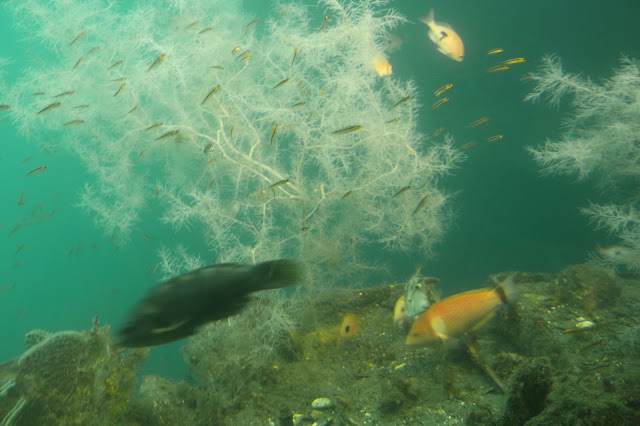
In Harrison Cove, Milford Sound, an floating underwater observatory is attached to the cliff. This offers a glimpse of life under the water. There are very few places on the planet like Milford Sound’s underwater environment. Here, a phenomenon known as ‘deep-water emergence’ occurs where freshwater meets seawater and species which normally live at great depths survive in much shallower environments. Black Coral is known as a deep-sea coral, however, here in Milford Sound it is found just 10 metres below the surface.

Didn't expect to see a Triggerfish in Milford Sound.

Great to see all the fishes


Black corals are protected. The British Royal family have a cutlery set with black coral handles.
The coral is named for the dark colour of their hard proteinaceous skeletons.


When alive the skeleton is covered by living tissue and bears tiny polyps. The tissue covering the skeleton can be variously coloured. Consequently living black coral colonies do not look black eg Antipathes fiordensistypically appears white when alive.
 Colonies of black coral can look like trees, whips, fans or feathers. Some species may live for hundreds of years, and may grow over 3 m tall.
Colonies of black coral can look like trees, whips, fans or feathers. Some species may live for hundreds of years, and may grow over 3 m tall.

 Colonies of black coral can look like trees, whips, fans or feathers. Some species may live for hundreds of years, and may grow over 3 m tall.
Colonies of black coral can look like trees, whips, fans or feathers. Some species may live for hundreds of years, and may grow over 3 m tall.
About 58 black coral species are known in New Zealand waters and most appear to live at a depth of 200-1000 m. Divers are most likely to encounter black corals below 40 m depth on offshore reefs in northern New Zealand.


In Fiordland and parts of Port Pegasus, Stewart Island, Antipathes fiordensis may occur as shallow as 10 m depth. Several subtropical species are found on shallow reefs at the Kermadec Islands.

People can sometimes think of corals as some sort of plant, or as inanimate rocks or stones, but coral are in fact animals. And amazing animals at that.

Corals belong to the phylum Cnidaria. Other animals that belong to the phylum Cnidaria include jellyfish and sea anemones


People can sometimes think of corals as some sort of plant, or as inanimate rocks or stones, but coral are in fact animals. And amazing animals at that.

Corals belong to the phylum Cnidaria. Other animals that belong to the phylum Cnidaria include jellyfish and sea anemones







No comments:
Post a Comment